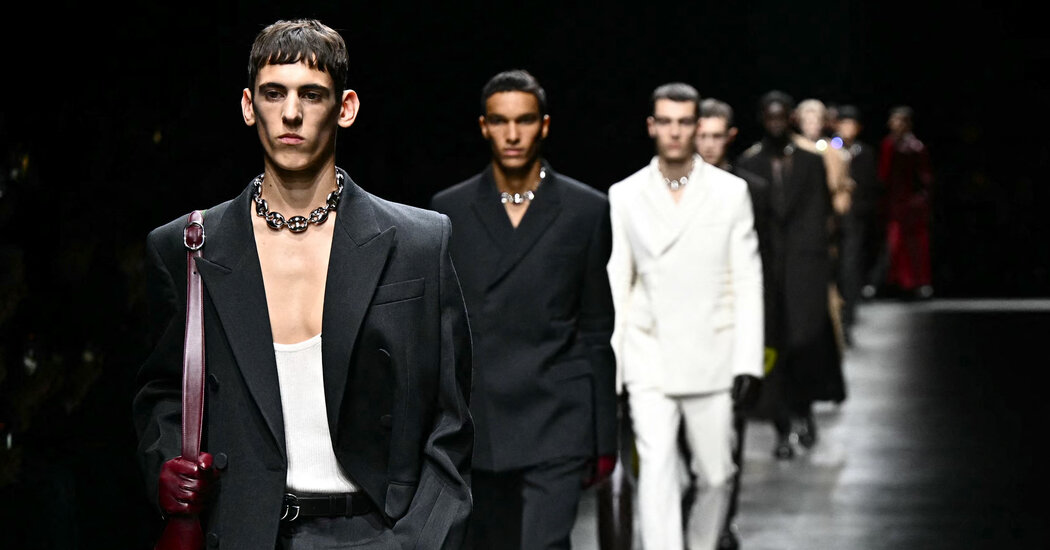The headline was Gucci. The headline was always going to be Gucci, in the same way the Ever Given was destined to dominate the news cycle when the mammoth vessel, one of the largest container ships ever built, got stuck in the Suez Canal back in 2021.
Gucci is, in a way, the Ever Given of the personal luxury goods trade. With more than 500 stores worldwide and an estimated market value in 2022 of $35.3 billion, it is that skyscraper-size tanker, caught sideways. The entire fashion business took a hit during the pandemic and then bounced back, or seemed to, with a surprising resilience. Then it encountered something that in its way was as unexpected as that grounding of a nautical behemoth thrown off course by fluke winds.
In Gucci’s case it was the fickleness of shifting taste. When Alessandro Michele, the former creative director of the brand — founded in Florence in 1921 as a leather goods manufacturer catering to a sophisticated carriage trade, and now owned by the luxury goods giant Kering — said in an interview with this reporter back in 2020 that “maybe one day I will not be relevant,” he was sending a signal, to both his bosses and the culture at large.
Mr. Michele was a creative savant and lucky, as he has said, to have survived a quarter century in the business largely by following his instincts (or his “stomach” as he said.) He knew. The instincts that helped elevate him from journeyman accessories designer to star were already giving him the itch to move on. This was largely because society was about to do the same.
The gender play Mr. Michele pioneered — pussy bows and rhinestones and tiger prints and baby-doll dresses on guys — and that for a brief, giddy and obscenely profitable moment drove Gucci’s valuation to great heights, were absorbed by the culture with alacrity. Harry Styles in a dress on Vogue’s November 2020 cover looked groundbreaking for about a minute. Harry Styles in a dress now would hardly rate a second glance.
And the not-so-dirty secret at every luxury goods house is that overall sales are driven not by apparel at all, but by leather goods, and not even costly handbags, at that. It would surprise people to learn how much profit there is in a logo key chain.
Gucci had to right the ship and return it to the mainstream. In attempting to do so, it hired as its new creative director Sabato De Sarno, a man so pragmatic by nature that interviewing him is less like consulting an ancient Greek sibyl, as was the case with Mr. Michele, than it is talking to the director of engineering at a boatyard.
“I love fashion, but I don’t love the idea of fashion,” Mr. De Sarno said one afternoon before his show on Thursday. “I want to make things to use and wear, and not just things for shows or red carpet or editorials.”
Seen through that lens, he is as much a man of his moment as Mr. Michele was of his. Virtually every fashion house showing in Milan this week made clear its understanding that consumers, particularly young consumers, are through with the hype. Pragmatism was the subtext of the best collections, and those were provided by labels as unalike as Prada, Tod’s, Neil Barrett and Brunello Cucinelli. At each of those houses there was an emphasis on craftsmanship, which nowhere is as refined as it is in Italy.
The cliché on the Little Italy T-shirts turns out to be true: Italians Do It Better. Yes, there was the Renaissance. But for present purposes it is the marriage of craft, industrial design and high aesthetic values, which began here in the early 20th century, when the novel idea of providing luxury goods for the masses arose.
Those early designers and, eventually, scores of others put centuries-old artistic traditions to industrial use. It is premature to associate what Mr. De Sarno is doing with the work of giants like the architect and designer Gio Ponti. Yet the impetus is there, and the collection Mr. De Sarno presented — a follow-up to a heavily-criticized teaser he presented during the women’s wear shows in September — made a strong case for him as a plausible successor to industrial innovators who refuted narrative, and focused instead on materiality and craft.
The knock on the De Sarno Gucci show was that it was commercial, as though there was something wrong with drilling down into the Gucci archives and sampling what he uncovered. There were versions of the original snaffle-bit loafer, interpreted variously as soft and lug soles or else studded brothel creepers; enlarged versions of the celebrated Jackie bag that Samuel Beckett, of all people, once slung over his shoulder; versions of the elegantly tailored outerwear Gucci was renowned for, although rendered in “Through the Looking Glass” volumes.
There were also versions of GG monogram suits in which the logo receded to become a kind of human gift-wrapping, and of previous designers’ faux-fur topcoats that made reference to Mr. De Sarno’s own love of cozy and protective garb. (He said he has 240 coats in his personal collection; coats are his security blanket.)
“I opened the show with the same coat, the same silhouette, the same bag” as he showed during women’s wear, Mr. De Sarno told Vogue.com, as though he were flipping his critics the bird.
“I don’t care about the Instagram moment,” he added in conversation with this reporter, using saltier language. The Instagram moment, we all know, cannot be avoided. But it is not what floats Sabato De Sarno’s boat.







